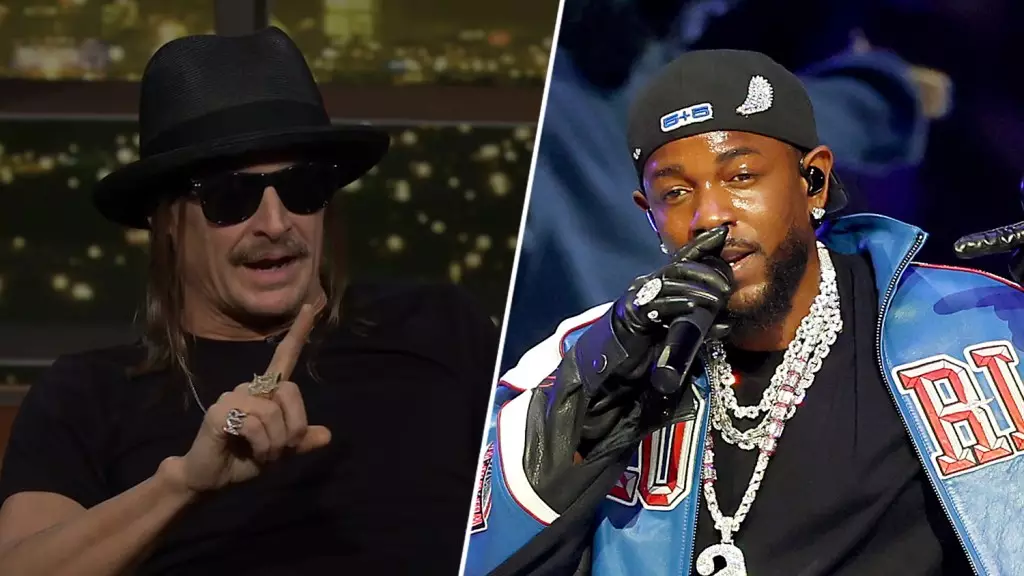The Super Bowl halftime show has long been a platform for artists to showcase their talents on one of the largest stages in the world. Kendrick Lamar, a prominent figure in contemporary hip-hop, brought his unique artistry to this year’s event, stunning many viewers with a performance layered in meaning and cultural significance. However, it was Kid Rock’s highly critical response on ‘Real Time with Bill Maher’ that set the internet abuzz, amplifying the discussion around race, representation, and the cultural implications of DEI (Diversity, Equity, and Inclusion) frameworks.
The Reaction to Lamar’s Performance
Kendrick Lamar’s performance was not just a musical set; it was a statement that resonated with many fans, particularly in light of the Super Bowl’s broader cultural context. But Kid Rock, who positioned himself as someone with a claim to hip-hop culture, expressed his discontent, stating that Lamar’s act represented “the epitome of DEI blowing up.” This phrase, cryptic and charged, seemed to imply that the performance was an exaggerated reflection of initiatives aimed at inclusivity, which he viewed sceptically.
Nevertheless, Rock provided a nuanced context for his criticism. He claimed familiarity with hip-hop, suggesting that his background allowed him to critique the authenticity of the performance. While he admitted that it wasn’t his “cup of tea,” he recognized the talent and unapologetic nature of Lamar’s artistry, showcasing a duality that many critics struggle to navigate. This acknowledgment opens a conversation about how personal taste can influence one’s perception of artistic merit.
A Critique of DEI in Performance Arts
Rock’s assertion that Kendrick’s performance was an example of DEI gone awry raises questions about the efficacy and perception of diversity initiatives in the arts. He articulated a belief that the halftime show was not an inclusive representation of the NFL’s diversity efforts, but rather an exclusionary experience that catered primarily to a Black audience. The irony of such commentary emerging from a white artist emphasizes the complexities surrounding discussions of race and representation in spaces traditionally dominated by white cultures.
His critique appears to stem from a deeper concern regarding how efforts to promote diversity can sometimes backfire, leading to perceptions of segregation or elitism rather than genuine inclusion. Kid Rock’s remarks, albeit contentious, point towards the ongoing struggle to balance authenticity and representation within performance arts—issues that artists and organizations face in increasingly polarized cultural climates.
As Rock discussed the connection between Colin Kaepernick’s peaceful protest and Lamar’s Super Bowl inclusion, he highlighted a pivotal moment in American sports and culture. The intersection of Kaepernick’s activism and Lamar’s platform ignites discussions about the responsibilities art holds within societal issues, particularly when addressing race, politics, and identity.
Kendrick’s performance, laden with metaphor and imagery, served as a reminder of the turbulent history of Black Americans and their continuous fight for equality. Kid Rock’s sentiment that Kaepernick deserves acknowledgment in this context illustrates a broader awareness of how historical actions transcend sports and meld into the arc of American identity. Acknowledging these connections presents an invitation for audiences to dig deeper into the meanings behind such performances, challenging them to engage with the political and social ramifications of artistic expression.
Kendrick Lamar’s Super Bowl performance sparked a necessary discussion, not only about the nature of hip-hop and its cultural roots but also about the complexities surrounding representation in mainstream spaces. While Kid Rock’s reaction may have polarized opinions, it ultimately served as a reminder of the diverse perspectives that coexist in conversations about culture, race, and inclusion.
Art, particularly in a grand spectacle like the Super Bowl halftime show, serves as a microcosm of society, reflecting its intricacies and tensions. As audiences grapple with these rich narratives, they are invited to not only enjoy the performances but also to reflect critically on their implications in a modern context. Recognizing the power of performance can catalyze deeper understandings of identity, community, and ultimately, the multifaceted nature of American culture.
